Think Florida’s all about beaches and theme parks? Think again. This sunshine state hides some of the most stunning hiking trails you’ll ever explore. From dense forests to serene wetlands, Florida offers a diverse range of landscapes that promise adventure and tranquility.
Whether you’re a seasoned hiker or just looking for a weekend escape, these 15 epic hikes will take you through some of the most breathtaking scenery Florida has to offer. Lace up your boots and get ready to discover the natural beauty that often gets overshadowed by the state’s more famous attractions.
Key Takeaways
- Diverse Landscapes: Florida offers a variety of hiking experiences, from dense forests and serene wetlands to coastal trails and prairies.
- Unique Trail Features: Trails typically feature flat terrain, are prone to flooding in wetlands, and offer abundant wildlife sightings including alligators and various bird species.
- Best Hiking Times: The ideal time to hike in Florida is during the cooler, dryer months from November to March to avoid extreme heat and flooding.
- Top Trails: Notable trails include Paynes Prairie Preserve State Park, Black Bear Wilderness Loop, and the Florida Trail in Ocala National Forest.
- Essential Gear: Important items to bring on your hike include waterproof shoes, bug spray, sunscreen, plenty of water, and a first aid kit.
- Safety Tips: Stay hydrated, protect yourself from the sun, be aware of wildlife, and always stick to marked trails for a safe hiking experience.
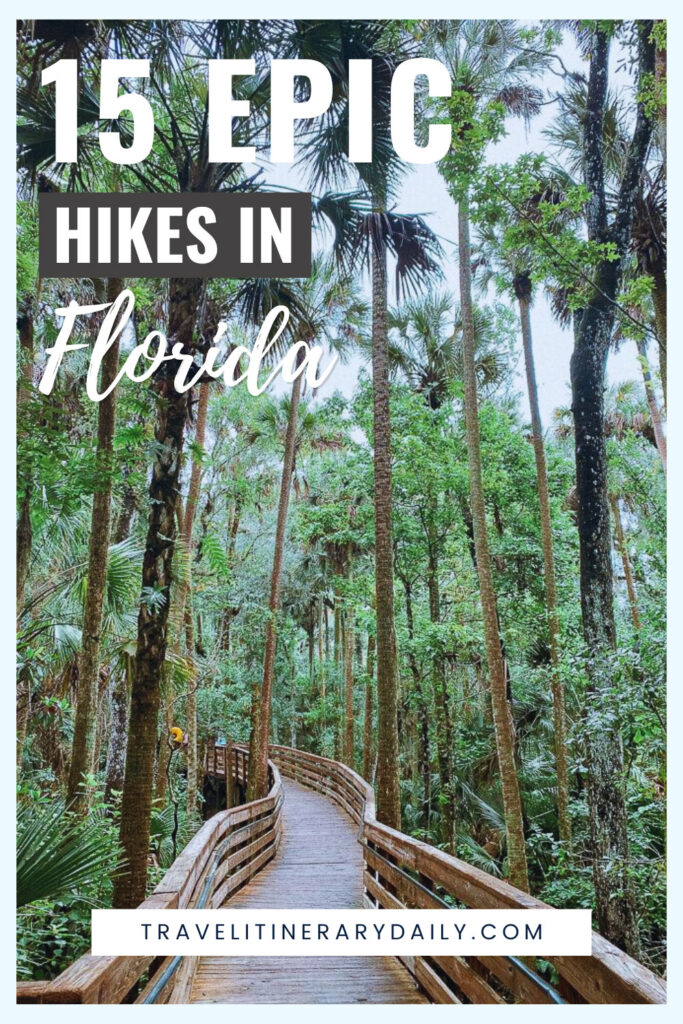
Overview Of Hiking In Florida
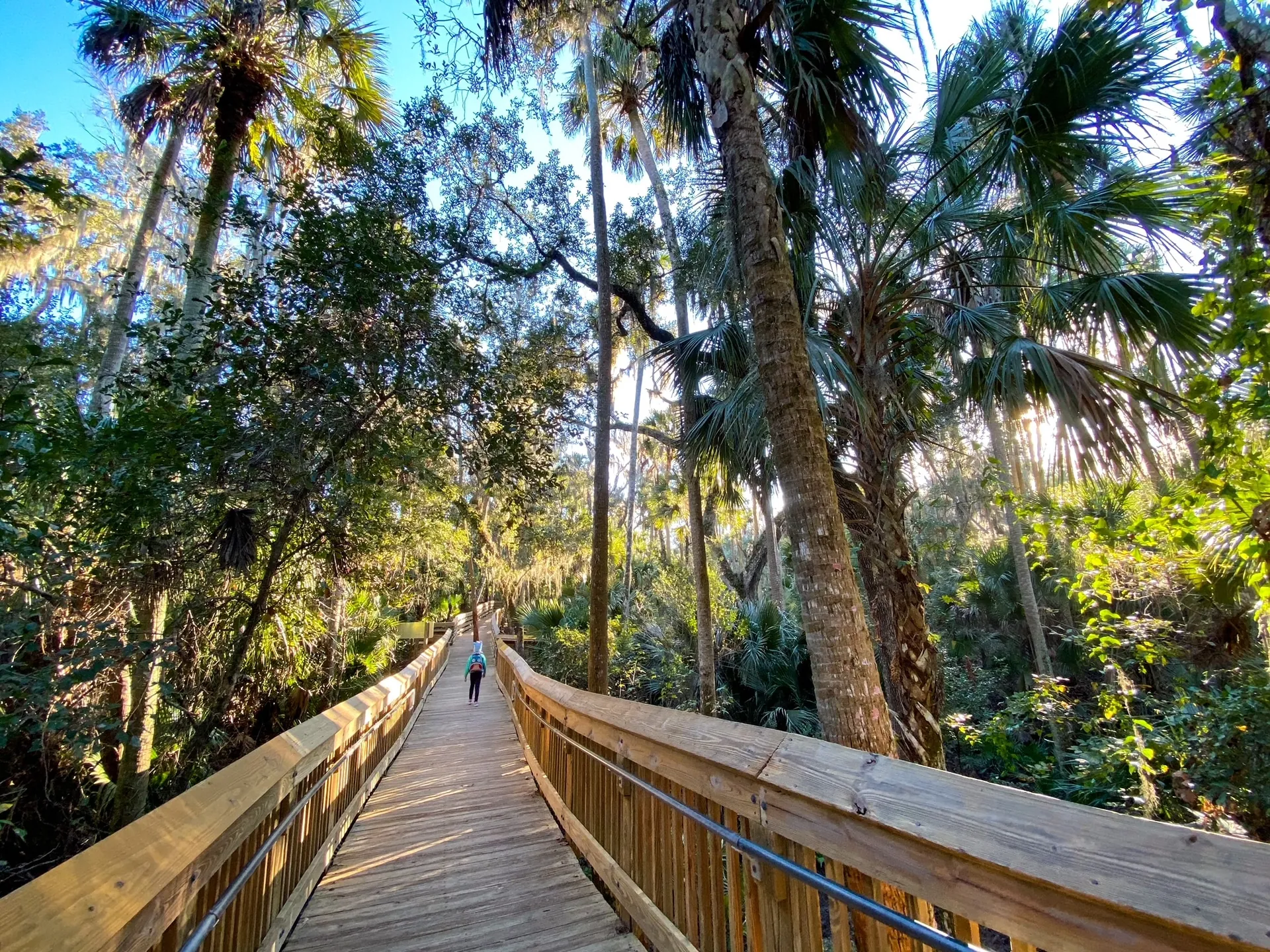
Hiking in Florida offers a unique and diverse range of experiences, distinct from hiking in other states due to its unique geography.
Unique Characteristics Of Florida Hiking Trails
- Flat Terrain
Florida hiking trails are generally flat, often featuring sandy trails or boardwalks rather than rocky or mountainous terrain. - Wetlands And Flooding
Many trails in Florida traverse through wetlands and can be prone to flooding. Boardwalks are common to keep hikers dry. - Wildlife And Ecosystems
Florida’s trails are known for their abundant wildlife, including alligators, snakes, black bears, and various bird species. The state’s diverse ecosystems range from prairies and forests to swamps and coastal areas.
Top Hiking Trails In Florida
- Paynes Prairie Preserve State Park – La Chua Trail
- Location: Central Florida
- Mileage: 2
Brief Overview
- Location: Florida’s diverse trails are spread across the entire state, from the Panhandle to the Keys.
- Climate: Florida has a humid subtropical climate in the north and central areas, while the southern part experiences a tropical climate. Expect wet, hot summers and mild, dry winters.
- Best Time To Visit: The ideal time for hiking is during the cooler months from November to March. This period offers moderate temperatures and minimal rainfall.
Top Attractions
- Everglades National Park: Spanning 1.5 million acres, enjoy trails surrounded by unique wetlands and rich wildlife.
- Ocala National Forest: Features the Florida Trail, multiple springs, and dense pine forests.
- Biscayne National Park: Offers coastal hiking experiences with marine life views.
- Myakka River State Park: Known for birdwatching and opportunities to see alligators from a safe distance.
- Big Cypress National Preserve: Offers diverse ecosystems, including cypress swamps and hardwood hammocks.
Hidden Gems
- Black Bear Wilderness Loop: Offers a remote, challenging trail with chances to spot Florida black bears.
- Juniper Springs Recreation Area: Less crowded spring-fed trails with lush vegetation.
- San Felasco Hammock Preserve State Park: Provides shaded trails through old-growth forests with fewer visitors.
- Weedon Island Preserve: Coastal mangrove trails with rich archaeological history.
- Lake Louisa State Park: Primarily known for its tranquil, scenic world and less crowded trails.
Accommodations
| Location | Budget Options | Mid-Range Hotels | Luxury Resorts |
|---|---|---|---|
| Everglades National Park | Campgrounds | Everglades City Inns | Marco Island Resorts |
| Ocala National Forest | State Park Cabins | Silver Springs Lodges | Ocala Luxury Resorts |
| Biscayne National Park | Homestead Motels | Coral Gables Inns | Miami Beach Hotels |
| Myakka River State Park | Park Cabins | Sarasota Inns | Longboat Key Resorts |
| Big Cypress National Park | Ochopee Campsites | Naples Hotels | Naples Beach Resorts |
Dining Highlights
- Local Seafood: Try fresh catch from the Gulf of Mexico at waterfront restaurants.
- Farm-To-Table: Enjoy organic offerings from local farms at many eateries.
- Ethnic Cuisine: Discover a range of Caribbean, Cuban, and Latin American restaurants offering authentic dishes.
- BBQ Joints: Savor smoked meats in casual settings beloved by locals.
- Craft Breweries: Visit breweries offering local craft beers to complement your meals.
Transportation & Practical Tips
- Rental Cars: Essential for exploring remote trails.
- Public Transport: Limited, mainly in urban areas.
- Trail Maps: Download or carry physical maps due to spotty cell reception in some areas.
- Essential Gear: Include insect repellent, sunscreen, and watertight bags. Prepare for sudden weather changes.
- Hydration: Carry plenty of water. Tap water in remote areas might not be reliable.
- Sustainability Tips: Stay on marked trails, pack out trash, respect wildlife, and limit noise pollution.
Seasonal Variations
- Summer: High heat and humidity. Plan hikes early in the morning or late in the evening.
- Winter: Mild temperatures, ideal for hiking. Also the dry season, reducing flood risks.
- Spring and Fall: Transitional weather, fewer crowds, blossoming flora in spring.
- Camping: Cheapest option. Fees range from $15 to $30 per night.
- State and National Parks: Entrance fees range from $5 to $30.
- Gear Purchase/Rental: Invest in quality gear if frequenting trails; rental options available in major cities.
In this overview, encounter the diverse beauty and complexity of Florida’s hiking trails, from flat terrains to rich ecosystems. Embrace practical tips, thriving wildlife, and seasonal advice to plan an unforgettable experience.
North Florida Epic Hikes
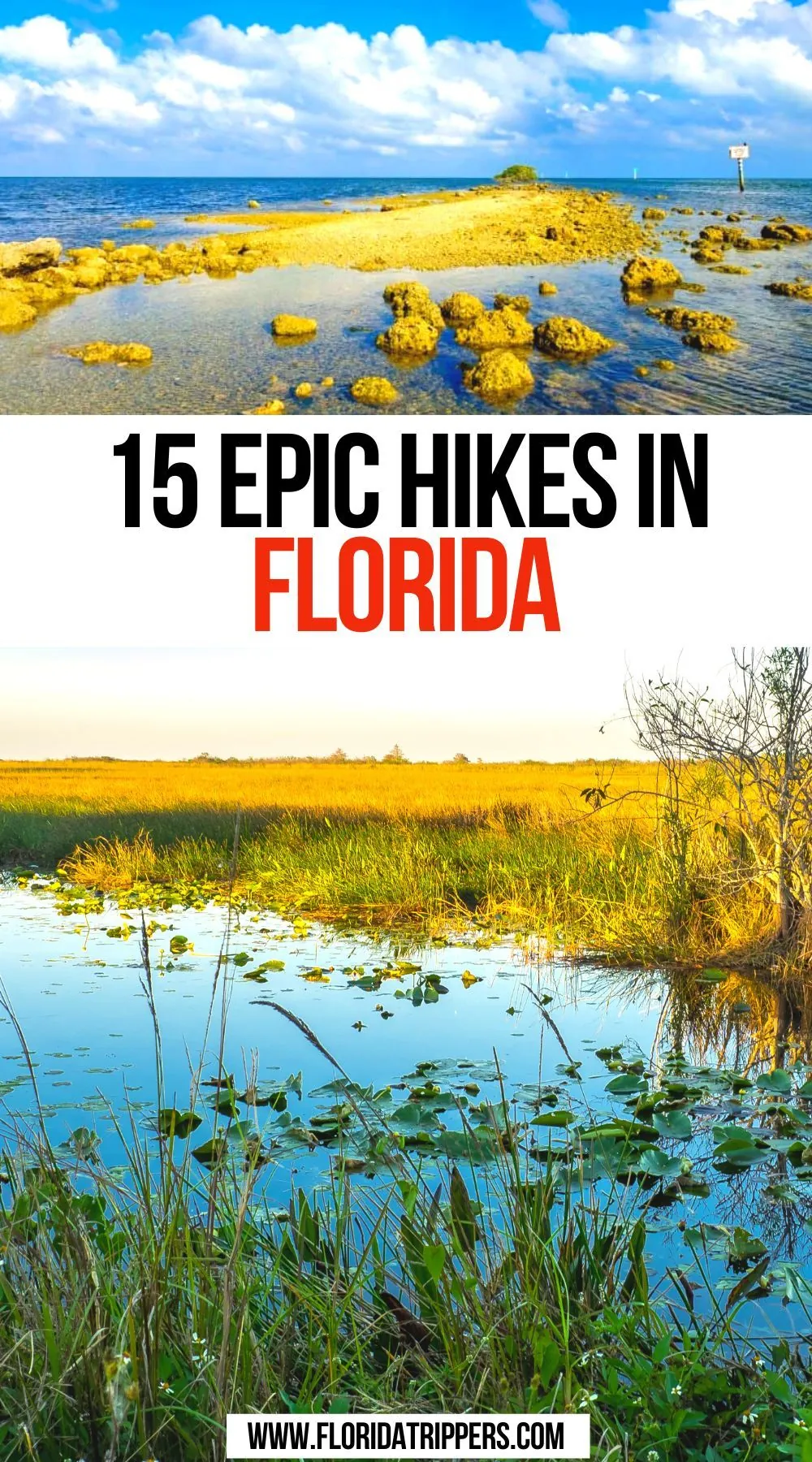
North Florida offers some of the most diverse and scenic hikes in the state. From the lush forests to the rushing rivers, you’ll find trails that suit both casual hikers and seasoned adventurers.
Blackwater River State Forest
Blackwater River State Forest, northeast of Pensacola, features the northernmost section of the Florida National Scenic Trail. The trail follows the Blackwater River, known for its massive red clay bluffs, white sand beaches, and large sandbars. The dark, tannic water provides a striking contrast against the surrounding world. Expect to encounter wildlife such as gopher tortoises, great blue herons, wild turkeys, white-tailed deer, and opossums.
Top Attractions:
- Scenic river views
- Red clay bluffs and sandbars
- Abundant wildlife sightings
Torreya State Park
Located about an hour west of Tallahassee in Bristol, Torreya State Park is known for its challenging trails, often called the “Mountains of Florida”. The Torreya Challenge Loop spans 7 miles, while the Rock Creek Loop covers 6 miles. Both trails offer demanding climbs and stunning vistas.
Top Attractions:
- Torreya Challenge Loop (7 miles)
- Rock Creek Loop (6 miles)
Florida Trail Ocala
The Florida Trail Ocala section traverses Ocala National Forest, offering diverse ecosystems from sand pine scrub to hardwood hammocks. Hike through Juniper Prairie Wilderness or Alexander Springs for a unique experience. The trail’s features include stunning water views and rich biodiversity.
Top Attractions:
- Juniper Prairie Wilderness
- Alexander Springs
Little Talbot Island
Little Talbot Island State Park, near Jacksonville, boasts pristine beaches and diverse landscapes, from dunes to maritime forests. The 4-mile Dune Ridge Trail provides a mix of coastal and woodland scenery. Spot shorebirds, turtles, and even dolphins along the beach.
Top Attractions:
- Dune Ridge Trail (4 miles)
- Pristine beaches and dunes
Mike Roess Gold Head Branch State Park
Mike Roess Gold Head Branch State Park, in Keystone Heights, offers varied terrain with rolling sandhills, marshes, and lakes. Notable trails include the Loblolly Loop and the Florida National Scenic Trail section, providing beautiful vistas and a peaceful hiking experience.
- Loblolly Loop
- Florida National Scenic Trail section
Central Florida Epic Hikes
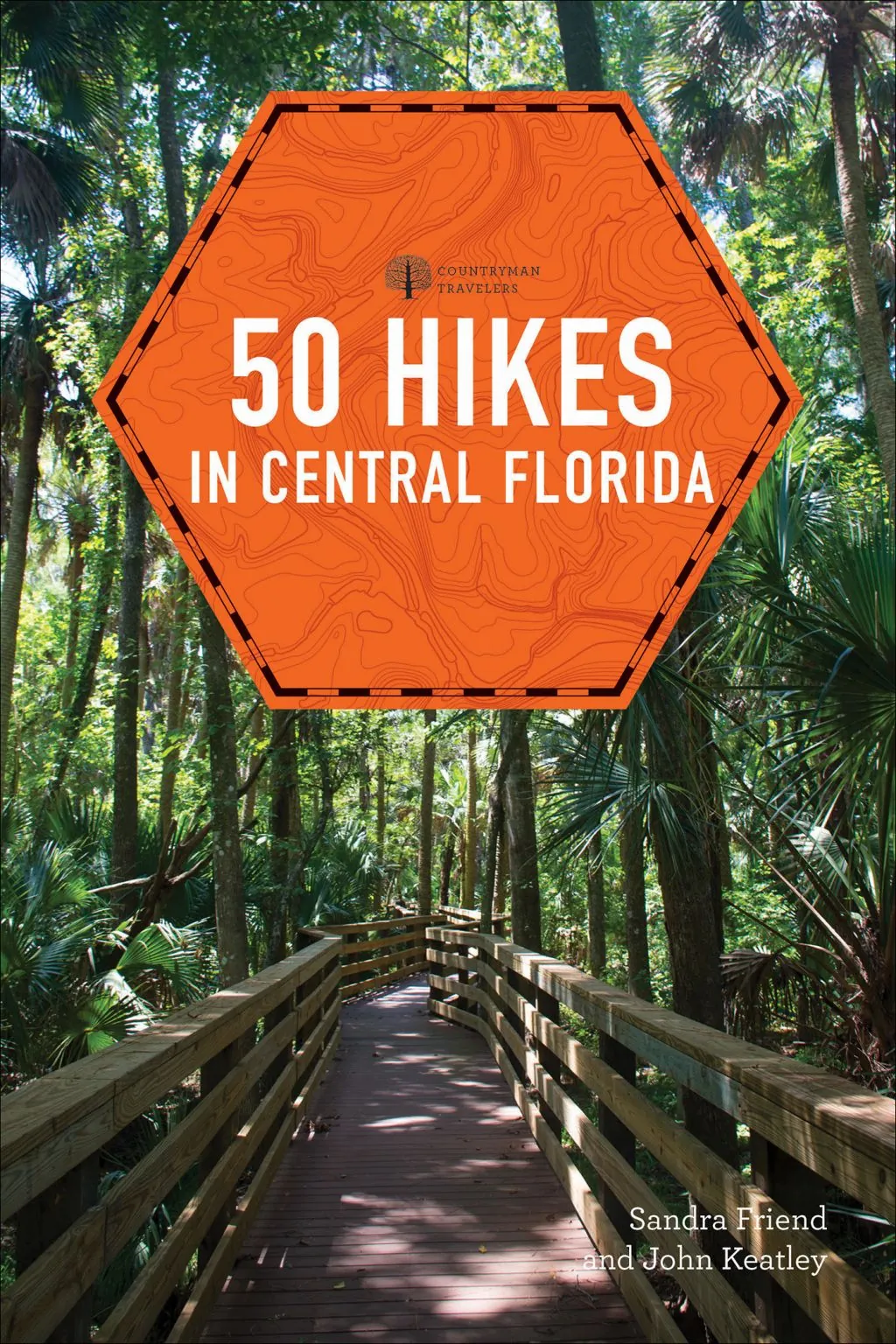
Central Florida offers some of the most rugged and scenic hikes in the state. The diverse landscapes range from rolling sandhills to serene riversides. Here are some of the must-visit trails in this region.
Citrus Hiking Loop
The Citrus Hiking Loop, spanning over 39 miles, is one of Florida’s most challenging trails. You’ll traverse rolling sandhills, rock-strewn footpaths, and steep descents, testing your endurance and hiking skills. Even though its difficulty, the trail’s well-maintained and clearly marked, ensuring you can navigate with ease. Typically taking around four days to complete, this loop offers immersion in Florida’s wild terrain.
Little Manatee River State Park
Located in Hillsborough County, Little Manatee River State Park features the 6.5-mile Little Manatee River Trail. This trail is part of the Florida Trail system and offers a chance to explore pine flatwoods, oak hammocks, and the scenic Little Manatee River. Scenic views and abundant wildlife, including alligators, birds, and deer, make this a memorable hike.
Hillsborough River State Park
Hillsborough River State Park combines natural beauty with historical sites. The park’s trails, such as the Baynard Trail, cover approximately 3.4 miles. These trails take you through lush forests and along the Hillsborough River. The park’s suspension bridge offers stunning views, and you might spot local wildlife like turtles and otters.
Lake Kissimmee State Park
Lake Kissimmee State Park’s Buster Island Loop Trail spans 6.7 miles. It guides you through varied landscapes, including pine flatwoods, oak hammocks, and marshes. The park is famous for its diverse birdlife, making it a great spot for birdwatching. Camping facilities are available if you want an overnight adventure.
Flat Island Preserve
Flat Island Preserve offers a quieter hiking experience. The main trail spans around 2 miles and takes you through shady oak forests and wetlands. Boardwalks provide easy access over marshy areas. The preserve’s secluded nature makes it perfect for a peaceful day hike, offering glimpses of birds and small wildlife in their natural habitat.
South Florida Epic Hikes
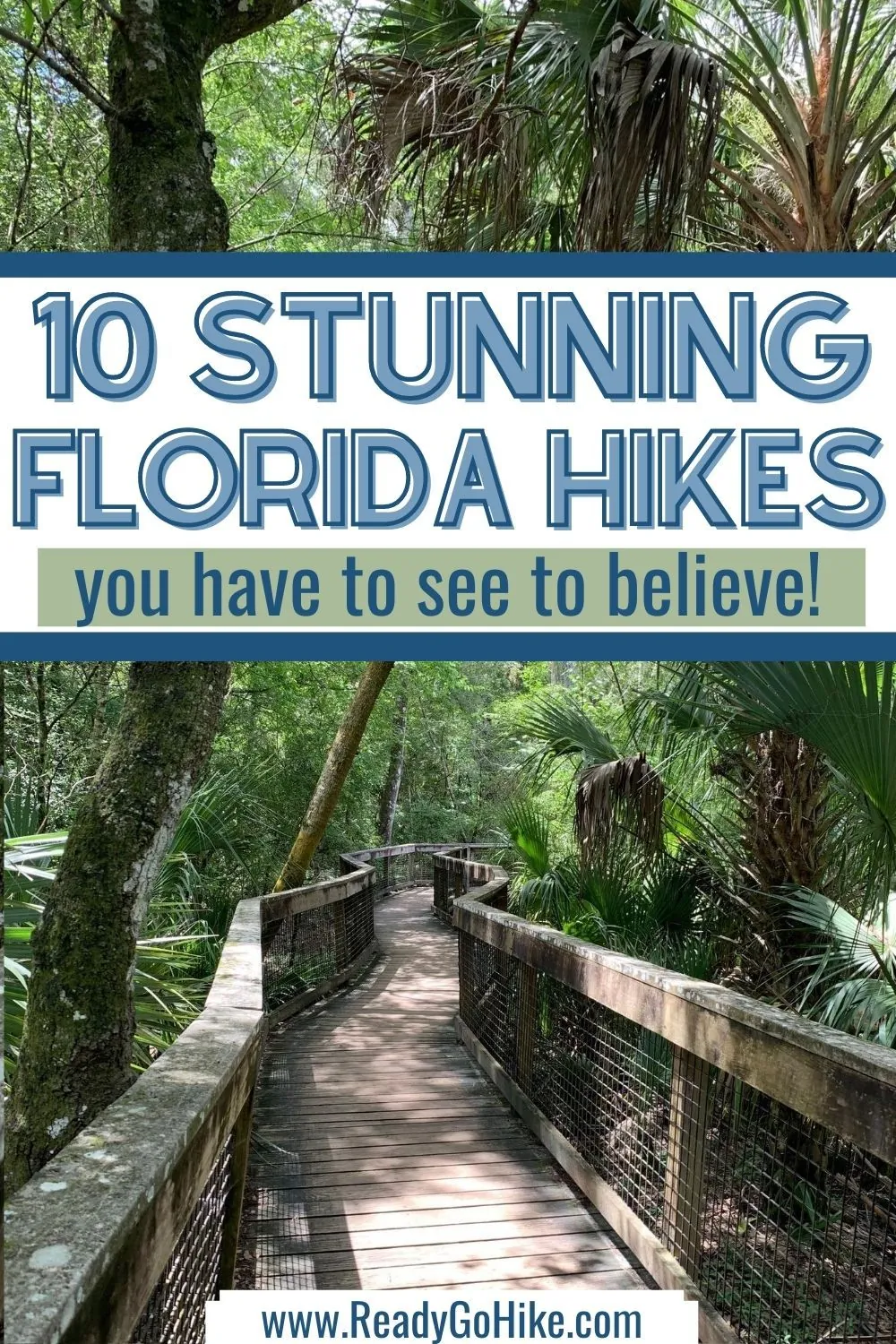
South Florida offers some of the most scenic and adventurous hiking trails in the state. From swamps to coastal landscapes, these epic hikes promise diverse experiences.
Big Cypress National Preserve
Located in southwestern Florida, the Big Cypress National Preserve is a place where swamps meet freshwater sloughs and pine rocklands. The diverse ecosystem attracts both nature enthusiasts and avid hikers.
Hiking Trails:
- Florida Trail: Extending through the preserve, this trail showcases diverse habitats and is part of the longer Florida National Scenic Trail.
- Bear Island Trail: A 17.5-mile out-and-back trail that winds through cypress swamps and pine flatwoods.
- Gumbo Limbo Trail: Though shorter, this trail offers a rich experience in a compact setting.
Keep your eyes peeled for wildlife, including wading birds, alligators, and the occasional panther.
Seabranch Preserve State Park
Nestled in Martin County, Seabranch Preserve State Park combines coastal hikes with inland trails, offering a unique Floridian experience.
Hiking Trails:
- Sand Pine Trail: At 3 miles, this trail meanders through sand pine scrub and coastal hammock habitats.
- Hobe Sound National Wildlife Refuge: Adjacent to the park, offering extended hiking opportunities.
- Armadillo Trail: A shorter trail that provides an ideal introduction to the park’s diverse flora.
With a mix of ecosystems, this park is perfect for a serene yet immersive hiking experience.
Corkscrew Swamp Sanctuary
Situated in Naples, Corkscrew Swamp Sanctuary offers an unparalleled journey through ancient cypress forests and marshlands.
Top Attractions:
- Boardwalk Trail: A 2.25-mile loop that takes you through dense cypress forests and wet prairies.
- Living Machine: An educational exhibit showcasing water treatment naturally.
- Observation Decks: Perfect spots for birdwatching and photography.
Jonathan Dickinson State Park
Located near Hobe Sound, Jonathan Dickinson State Park spans diverse terrains from coastal dunes to dense forests.
Hiking Trails:
- Hobe Mountain Tower: Offers panoramic views of the park’s unique landscapes.
- Kitching Creek Trail: Extending 8 miles, this trail takes you through serene woods and wetlands.
- River Trail: A shorter trail that follows the Loxahatchee River, ideal for a relaxed hike.
Dagny Johnson Key Largo Hammocks Botanical State Park
Found on Key Largo, this park is known for its unique tropical hammock ecosystem.
Hiking Trails:
- Wild Tamarind Trail: A 2-mile loop that showcases tropical hardwoods and a variety of native plant species.
- Keys Heritage Trail: Connects various points of interest within the park.
- Mangrove Trail: Offers glimpses of the unique coastal mangrove ecosystems.
Accommodations:
| Name | Type | Amenities | Price Range |
|---|---|---|---|
| Everglades City Motel | Motel | Free Wi-Fi, Air Conditioning | $89 – $159/night |
| Wakulla Suites | Hotel | Pool, Kitchenette | $150 – $250/night |
| Baker’s Cay Resort | Luxury Resort | Spa, Watersports Rentals | $300 – $500/night |
Dining Highlights:
- Stone Crabs Restaurant: Famous for fresh seafood.
- Island Fish Company’s Marina Bar: Offers casual dining with sunset views.
- Cafe Moka: Known for organic coffee and pastries.
Transportation & Practical Tips:
- Rent a Car: Essential for exploring multiple hiking spots.
- Season Preparation: South Florida can be hot; early mornings and late afternoons are best for hiking.
- Stay Hydrated: Bring plenty of water; dehydration can be a risk.
With these epic hikes in South Florida, you’re set for unforgettable adventures amidst the state’s diverse and captivating natural beauty.
Safety Tips For Hiking In Florida
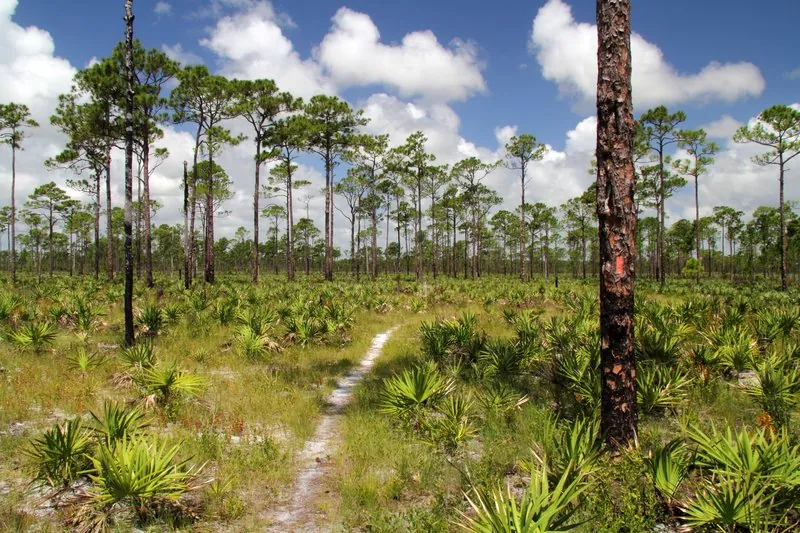
Maintain awareness of essential safety tips to ensure a safe and enjoyable hiking experience in Florida’s diverse landscapes.
Stay Hydrated
Bring adequate water. Florida’s high temperatures and humidity levels lead to rapid dehydration. Aim for at least one liter of water per hour of hiking.
Protect Yourself from the Sun
Florida’s sun can be intense. Wear sunscreen with SPF 30 or higher, a wide-brimmed hat, and sunglasses to protect your skin and eyes from UV rays. Opt for lightweight, long-sleeved clothing for added protection.
Be Aware of Wildlife
Florida’s trails are home to various wildlife, including alligators, snakes, and insects. Maintain a safe distance from animals, and never feed or provoke them. Use insect repellent to protect against mosquitoes and ticks.
Check the Weather
Florida’s weather can be unpredictable. Before heading out, check the forecast for rain and thunderstorms. Avoid hiking during extreme weather conditions for your safety.
Dress Appropriately
Wear moisture-wicking clothes to stay dry and comfortable. Use hiking boots with good traction to navigate diverse terrains, including wet and sandy paths.
Plan Your Route
Familiarize yourself with the trail map and let someone know your hiking plan. Ensure you have a fully charged phone and consider carrying a portable charger.
Start Early
Begin your hike early in the morning to avoid the midday heat and give yourself ample time to complete the trail before nightfall.
Avoid Overexertion
Florida’s heat can lead to heat exhaustion or heat stroke. Take breaks in the shade, and listen to your body. If you feel lightheaded or nauseous, rest immediately.
Use Safeguards
Carry a first aid kit, and know basic first aid procedures for common injuries like cuts, scrapes, and insect bites. Emergency contact numbers should be readily accessible.
Stay on Marked Trails
Stick to designated paths to protect fragile ecosystems and avoid getting lost. Trails are marked for your safety, and venturing off can lead to unexpected hazards.
Emergency Preparedness
Be prepared for emergencies by learning the location of the nearest medical facilities. Carry an emergency whistle and a flashlight for signaling or illumination if necessary.
Safety in Florida’s beautiful yet challenging environments is paramount. Following these tips ensures that your hiking adventure remains enjoyable and secure.
Best Times To Hike In Florida
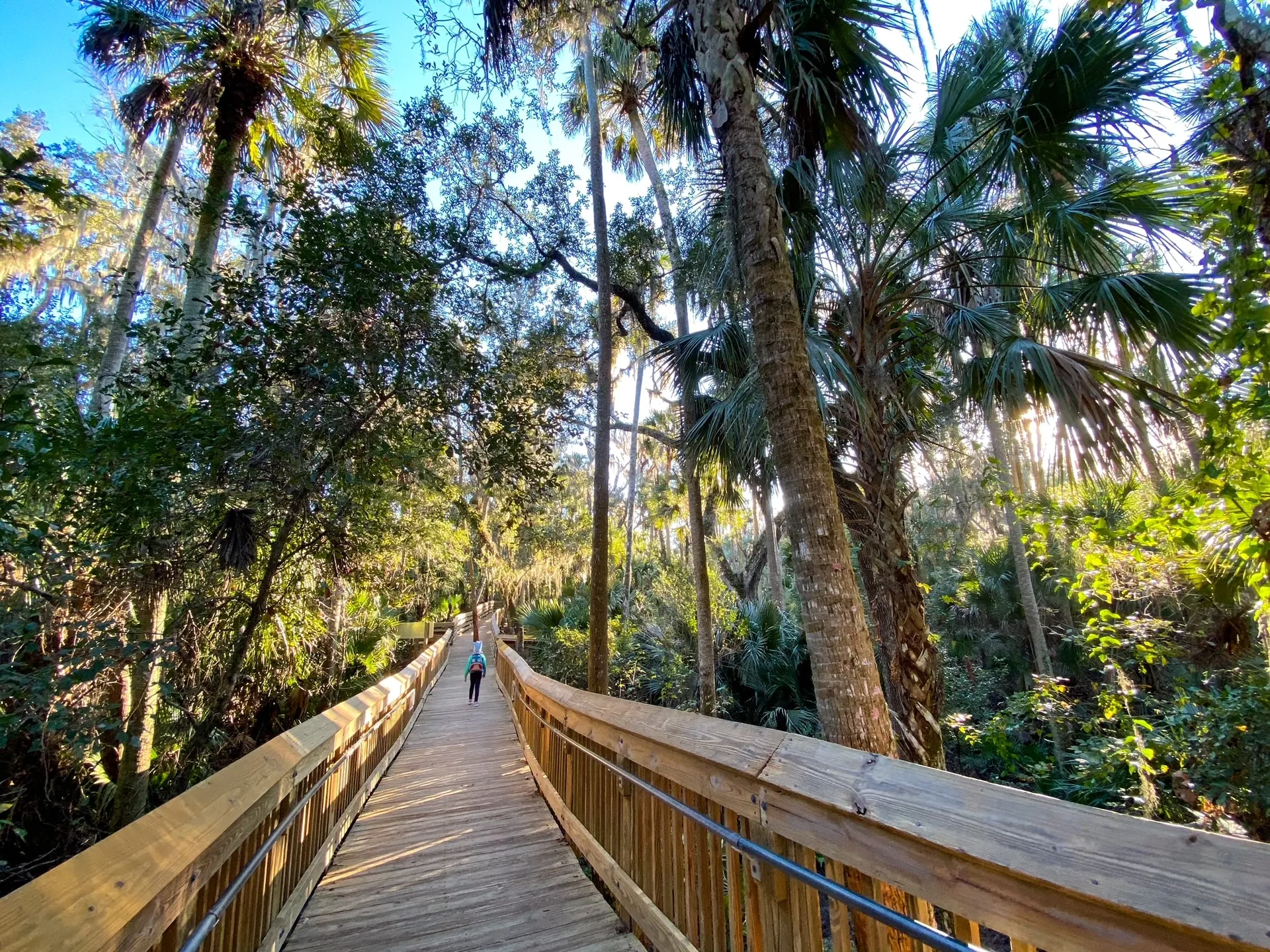
Hiking in Florida offers unique challenges and unforgettable experiences due to its diverse climate and geography. The best times to hike vary across the state and depend on the weather, trail conditions, and wildlife activity.
Seasonal Overview
Florida experiences two primary seasons: the dry season (November to April) and the wet season (May to October). The dry season is generally the best time for hiking. Temperatures are cooler, humidity levels are lower, and there is less rainfall.
- Dry Season (November-April): With daytime temperatures ranging from 50-70°F, this period is ideal for hiking. You’ll find fewer bugs and enjoy clearer skies. Trails are more accessible, and wildlife is active, offering excellent viewing opportunities.
- Wet Season (May-October): Temperatures can soar above 90°F with high humidity, making hiking strenuous. Afternoon thunderstorms are frequent, and some trails may flood. But, early morning hikes can still be enjoyable if you’re prepared for the heat and moisture.
Regional Considerations
Different regions in Florida offer variations in climate and trail conditions throughout the year.
- North Florida: The cooler temperatures make it ideal for hiking almost year-round, though the best times are during the fall and spring. For example, exploring the Blackwater River State Forest allows you to witness vibrant fall foliage.
- Central Florida: Winter months provide the most comfortable conditions. Trails such as the Black Bear Wilderness Area Trail are bustling with wildlife during these cooler months.
- South Florida: The dry season is essential for hiking here. The Everglades, including the Anhinga Trail, is best explored when water levels are lower, and alligators are more visible.
Wildlife and Trail Conditions
During the dry season, wildlife is more active and easier to spot. Bird migrations peak in the fall and spring, offering birdwatchers exceptional opportunities. But, the wet season brings lush landscapes, and certain species, like the alligator, are more visible in their natural wetlands habitat.
- Start Early: Begin your hike early in the morning to avoid the midday heat, especially during the wet season.
- Stay Hydrated: Always carry plenty of water to stay hydrated in Florida’s variable climate.
- Dress Appropriately: Wear moisture-wicking clothing, a hat, and sunscreen. In the wet season, pack rain gear and insect repellent.
- Check the Weather: Always check the local weather forecast before heading out. Be prepared for sudden changes, especially during the wet season.
Understanding the best times to hike in Florida and anticipating the state’s unique climate and trail conditions ensures you’ll have a safe, enjoyable adventure.
Essential Gear For Florida Hikes

Proper gear ensures you stay comfortable and safe while exploring Florida’s diverse landscapes. Consider the following items for your adventures:
- Waterproof Shoes: Many trails, such as the Black Bear Wilderness Area Trail in Sanford, traverse wetland areas. Waterproof shoes keep your feet dry during muddy conditions.
- Bug Spray: Florida’s warm, humid climate attracts mosquitoes and other insects, especially in places like Everglades National Park. Bug spray helps protect you from bites and discomfort.
- Sunscreen: The sun can be intense, particularly on open trails like the Anhinga Trail. Sunscreen prevents sunburn and reduces the risk of skin damage.
- Water: Staying hydrated is crucial, especially in hot and humid weather. Bring ample water, particularly for longer hikes like those in Blackwater River State Forest.
- Hat and Sunglasses: Protect your eyes and face from the sun’s rays with a wide-brimmed hat and UV-blocking sunglasses.
- First Aid Kit: Minor injuries can occur, so a basic first aid kit with adhesive bandages, antiseptic wipes, and tweezers is essential.
- Trail Snacks: Energy-rich snacks like nuts, jerky, and dried fruits keep your energy levels up during your hike.
- Map and Compass: Though many trails are well-marked, having a map and compass ensures you stay on track, particularly in less trafficked areas.
- Rain Gear: Afternoon showers are common, especially during the wet season. A lightweight, packable rain jacket keeps you dry.
- Multi-tool or Knife: Useful for a variety of tasks, from cutting rope to preparing food.
- Camera: Capture the stunning vistas and unique wildlife you encounter on Florida’s scenic trails.
Equipping yourself with the right gear enhances your hiking experience and helps you fully enjoy Florida’s natural beauty.
Conclusion
Florida’s hiking trails offer a unique blend of adventure and tranquility that goes beyond its famous beaches and theme parks. From the dense forests of North Florida to the serene wetlands of the South, there’s a trail for every type of hiker. Whether you’re exploring hidden gems or well-known parks, these 15 epic hikes showcase the state’s stunning natural beauty.
Remember to equip yourself with the right gear and follow essential safety tips to make the most of your hiking experience. Embrace the diverse landscapes and abundant wildlife that make Florida’s trails truly special. Happy hiking!
Frequently Asked Questions
What Makes Hiking in Florida Unique?
Florida boasts diverse landscapes, including dense forests, wetlands, and beaches. These unique biomes, along with flat terrain and abundant wildlife, make hiking in Florida a distinct experience compared to other states.
When Is The Best Season For Hiking In Florida?
The dry season from November to April is ideal for hiking in Florida due to cooler temperatures and lower humidity. The wet season from May to October brings high heat and afternoon thunderstorms, making hiking more challenging.
What Are Some Must-Visit Hiking Locations In Florida?
Top hiking spots include Everglades National Park, Paynes Prairie Preserve State Park, Black Bear Wilderness Loop, and Juniper Springs Recreation Area. Each offers unique natural beauty and diverse hiking experiences.
What Wildlife Can I Expect to See While Hiking in Florida?
Hikers may encounter alligators, various bird species, and other wildlife along Florida’s trails. Always practice caution and respect wildlife habitats to ensure a safe hiking experience.
What Essential Gear Should I Bring For Hiking in Florida?
Recommended gear includes waterproof shoes, bug spray, sunscreen, ample water, a hat and sunglasses, a first aid kit, snacks, a map and compass, rain gear, a multi-tool, and a camera. Proper gear enhances safety and enjoyment.
How Can I Ensure Safety While Hiking in Florida?
Stay hydrated, protect yourself from the sun, be aware of wildlife, check the weather, dress appropriately, plan your route, start early, avoid overexertion, and be prepared for emergencies to ensure a safe hiking experience.
How Do Seasonal Variations Affect Hiking Conditions?
North Florida is suitable for year-round hiking. Central Florida is comfortable in the winter, and South Florida is best explored during the dry season. Seasonal variations impact temperature, humidity, and trail conditions.
What Are Practical Tips for Accommodations and Dining While Hiking?
Research nearby accommodations and dining options in advance. Consider staying in park lodges, campsites, or nearby towns and explore local eateries. Plan meals and lodging to enhance your overall hiking adventure.
Are There Any Hidden Gem Hiking Trails in Florida?
Yes, hidden gems like the Black Bear Wilderness Loop and Juniper Springs Recreation Area offer exceptional hikes with less foot traffic, allowing for a more tranquil and immersive outdoor experience.
What’s the Best Time of Day to Hike in Florida?
Early morning and late afternoon are the best times to hike in Florida. These times offer cooler temperatures and better wildlife viewing opportunities while avoiding the midday heat.
How Can I Prepare For Unpredictable Weather While Hiking in Florida?
Check weather forecasts before heading out and bring appropriate gear, such as rain jackets and waterproof bags. Be prepared for sudden weather changes, especially during the wet season.

